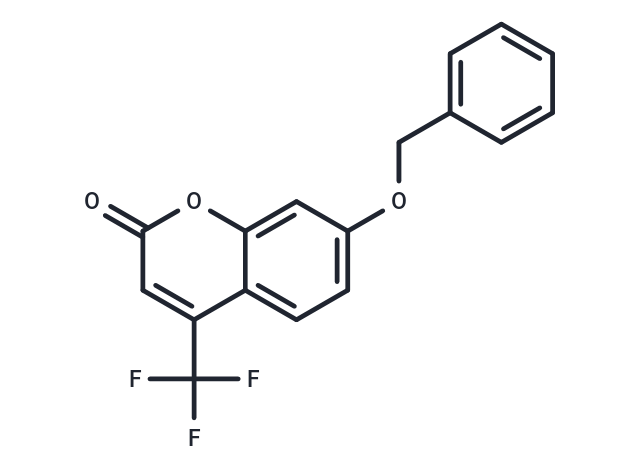Shopping Cart
Remove All Your shopping cart is currently empty
Your shopping cart is currently empty
7-BFC (7-Benzyloxy-4-(trifluoromethyl)coumarin) is a coumarin-like fluorescent substrate that serves as a biomarker for cytochrome P 450 and can be used to study CYP isoforms and cytochrome P 450 metabolism.

| Pack Size | Price | USA Warehouse | Global Warehouse | Quantity |
|---|---|---|---|---|
| 5 mg | $40 | In Stock | In Stock | |
| 10 mg | $64 | In Stock | In Stock | |
| 25 mg | $135 | In Stock | In Stock | |
| 50 mg | $213 | In Stock | In Stock | |
| 100 mg | $347 | In Stock | In Stock |
| Description | 7-BFC (7-Benzyloxy-4-(trifluoromethyl)coumarin) is a coumarin-like fluorescent substrate that serves as a biomarker for cytochrome P 450 and can be used to study CYP isoforms and cytochrome P 450 metabolism. |
| In vitro | I. CYP activity detection 1. Material preparation: 1) 7-BFC solution: usually prepared as a 1-10 µM solution, dissolved in an appropriate solvent (such as DMSO or PBS). 2) Enzyme source: CYP subtype (such as CYP3A4, CYP2D6, etc.) expression system, or use human liver microsomes. 3) Reaction buffer: usually use phosphate buffer (pH 7.4) containing NADPH to simulate the in vivo metabolic environment. 4) Fluorescence detection equipment: such as fluorescence spectrophotometer, excitation wavelength 405 nm, emission wavelength 460 nm (specific wavelength depends on the experimental setting). 2. Steps: 1) Prepare the reaction system: mix the 7-BFC solution with CYP subtypes or liver microsomes, and add NADPH as an electron donor. 2) Reaction incubation: Incubate the reaction system at 37°C for 15-30 minutes to allow 7-BFC to undergo metabolic reactions and produce fluorescence. 3) Fluorescence detection: Use a fluorescence spectrophotometer to detect the fluorescence intensity of the product, usually setting the excitation wavelength to 405 nm and the emission wavelength to 460 nm. 4) Data analysis: By measuring the changes in fluorescence intensity, the activity of cytochrome P450 and its metabolic efficiency on 7-BFC can be evaluated. II. CYP subtype-specific detection 1. Material preparation: 1) CYP subtype inhibitors: such as ketoconazole (an inhibitor of CYP3A4), or inhibitors of specific subtypes. 2) Metabolite analysis: Metabolites can be further analyzed by techniques such as high-performance liquid chromatography (HPLC). 3. Steps: 1) Set up experimental groups: Add different CYP inhibitors to identify the metabolic effects of specific CYP subtypes on 7-BFC. 2) Fluorescence detection and data analysis: Compare the fluorescence signal intensity of different inhibitors and untreated samples to further confirm the metabolic characteristics of specific CYP subtypes. Notes: 1) Reaction conditions: The choice of temperature, pH and buffer will affect the efficiency of the reaction and should be optimized according to the experimental requirements. 2) Solvent effect: When dissolving 7-BFC, a solvent that has no effect on the experimental system should be selected to avoid inhibition of CYP activity. 3) Fluorescence stability: The fluorescence signal of 7-BFC is relatively stable, but long-term exposure to strong light should be avoided. |
| Synonyms | Y040-0031, 7-Benzyloxy-4-(trifluoromethyl)coumarin |
| Molecular Weight | 320.26 |
| Formula | C17H11F3O3 |
| Cas No. | 220001-53-6 |
| Smiles | FC(F)(F)c1cc(=O)oc2cc(OCc3ccccc3)ccc12 |
| Relative Density. | 1.375 g/cm3 (Predicted) |
| Color | White |
| Appearance | Solid |
| Storage | Powder: -20°C for 3 years | In solvent: -80°C for 1 year | Shipping with blue ice/Shipping at ambient temperature. | |||||||||||||||||||||||||||||||||||
| Solubility Information | DMSO: 55 mg/mL (171.74 mM), Sonication is recommended. | |||||||||||||||||||||||||||||||||||
Solution Preparation Table | ||||||||||||||||||||||||||||||||||||
DMSO
| ||||||||||||||||||||||||||||||||||||
| Size | Quantity | Unit Price | Amount | Operation |
|---|

Copyright © 2015-2026 TargetMol Chemicals Inc. All Rights Reserved.